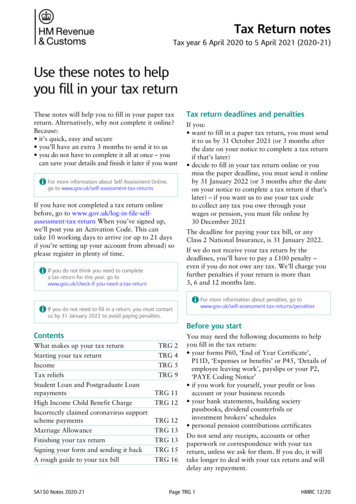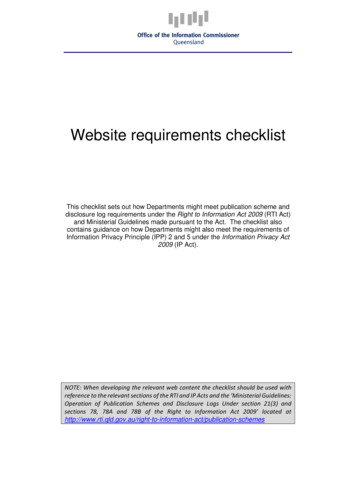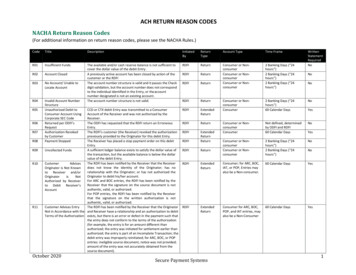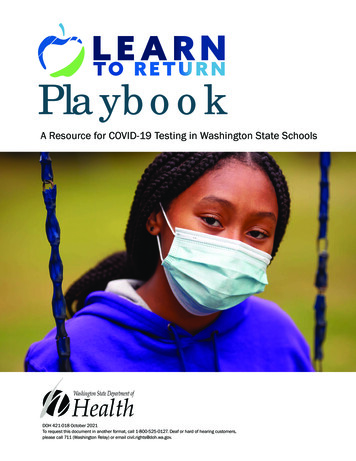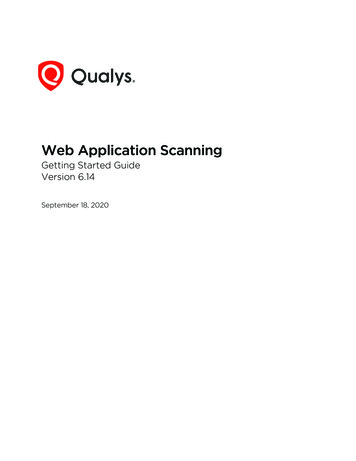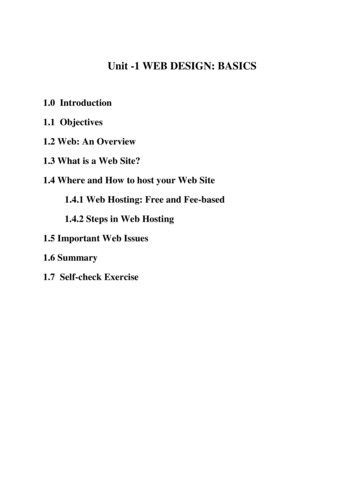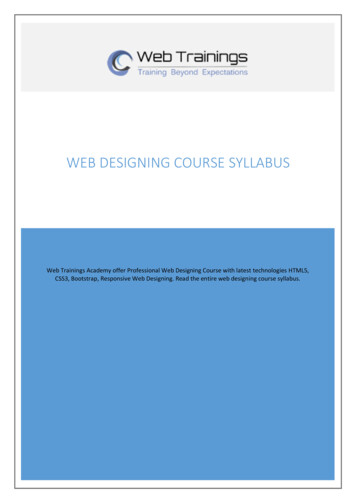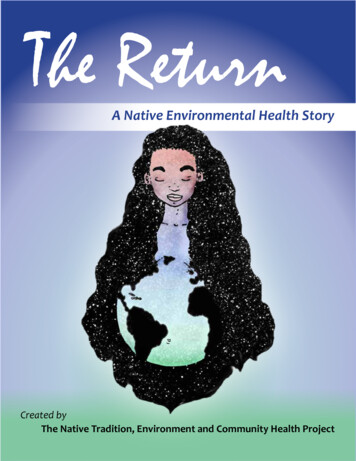
Transcription
The ReturnA Native Environmental Health StoryCreated byThe Native Tradition, Environment and Community Health Project
Dedicated to all the generous people whose time,energy, and wisdom helped craft this story.octNaivE AC H PTrejetWith special thanks to Janice Brendible, who firststood up and told the story that became The Return.Tradition, Environment AndCommunity Health University of Washington, 2013.This publication was made possible by Grant Number ES007033 from NIEHS. Its contents are solely theresponsibility of the authors and do not necessarily represent the official views of the NIEHS.
NAbout the Artisticholas “Nico” Salazar was born in Santa Fe, New Mexico 1987 to aSpanish BBQ Chef and hardworking hazel-eyed fitness instructor. Hisearly life was spent enjoying biscochito cookies and hearing ghost storiesfrom his grandparents.Ever since he could hold a pencil he has been creating works of art throughpainting, illustration, graphic design, jewelry, photography, and much more. Nico is currently a student at the Institute of American Indian Arts pursuing abachelors degree in painting and ceramics.In 2009, Nico and his best friend founded the design house known as The SoftMuseum where they collaborate on jewelry design, fine art and fashion photography.Nico resides in Santa Fe awaiting his next adventure. Until then he dances, creates,and daydreams in his little home in the high desert.The Soft Museum www.thesoftmuseum.com
TAbout the Storyhe Native Tradition, Environment And Community Health (TEACH) Project began in 2008with a small collaborative grant funded by the National Institute for Environmental Health Sciences.The Northwest Indian College and the Center for Ecogenetics and Environmental Health at theUniversity of Washington shared the funding and co-managed the project.In the Western scientific tradition, “Environmental Health” is the study of how the environment affects people inorder to promote healthier lives. One of the goals of the Native TEACH Project was to find out how Native waysof understanding the world and our place in it might lead to a unique understanding of environmental health – a“NATIVE Environmental Health Science.”To do this, we got input from Tribal college students, staff and faculty from 30 Tribal colleges around the U.S. Wedid this through a combination of talking circles, interviews, and written surveys administered at the NorthwestIndian College and at the 2009 American Indian Higher Education Consortium (AIHEC) student conference inMissoula, MT.When we sifted through the information we gathered, we identified three core themes that seemed to appear overand over: Community, Wellness, and Inter-Relationship.Each of these core themes contains many rich associations and layers. Each theme can best be understood as acircle. Native Environmental Health Science is the study of how these three circles intersect and overlap, and whatthis means for our actions as individuals and communities.The Return is an original story based on our research findings. With it, we hope to share the essence of what welearned from the rich conversations we had with Tribal college students, staff and faculty. It can be read quietly oraloud, used as a coloring book, or even serve as the spark for a group or classroom discussion. Mostly though, itis meant as a gift back to the many people who helped create it by sharing their time, insights, and wisdom.Contributors(in alphabetical order)Janice BrendibleKelly EdwardsAmber ForslundRose JamesAdib JamshediRegina Wilson JohnnyMary Teri Haldane KennedyMichelle MontgomeryAmy PaulNicholas SalazarValerie SegrestJon SharpeBuffy TowleThe Center for Ecogenetics and Environmental Health www.ecogenetix.orgThe Northwest Indian College www.nwic.orgThe Native TEACH Project www.nativeteach.orgThe National Institute for Environmental Health Sceinces www.niehs.nih.gov
This is a story of a womanwho knows that her baby iscoming soon.She wants to takeadvantage of the latesummer and finishgathering berries.1
She finds a beautiful place full of alldifferent sorts of berry bushes.2
There’s a path through the land andshe follows this path and begins to fillher basket with the sweet berries.As she’s gathering, a brightcircle buried deep within abush catches her eye.3
4
5
She reaches in andpulls out the circle.She sees thatit’s a table - around kitchentable. Shestops herpicking tolook at whatshe’s found.6
The table is made from heavy, dark wood thatis worn smooth from much use.7
She rejoices in the fact that this table is big enough notonly for her and her new baby, but also for her familyand her community.It is a place where people cancome together to solve problems,to share stories, to cry and laughand help one another.This table is Community.8
9
The womanbeginspickingagain.Soon abright circledraws herattentionfrom deepwithin abush.10
She reaches in andpulls out the circle . . . . . and sees thatit’s a drum.11
She stops to rest from hergathering and look at thisnew gift she’s been given.The drum isperfect in formand she holds itto her to warmit and feelshow the drumcarries themystery of lifeand creation.12
It remindsher of thebaby shecarries andhow sheand he areseparate,butconnected.What she eats, heeats. What shedrinks, he drinks.We are like thatwith the Earth too,she thinks.13
It is our womb and we are so dependent upon her for survival.How we treat Mother Earth is the most important legacy weleave our children. This drum is Wellness.14
Thewomancontinuespicking.15
When her basket is fulland she is ready to rest,another circle of lightcatches her eye.16
17
She reaches in andpulls out the circle andsees that it’s a nest - around, delicately wovenbird’s nest.She stops to look at whatshe’s found. The nest ismade from tiny, fragilereeds and twigs, but thenest is strong and sturdybecause of how wiselythese are joined together.She imagines the baby birdsthat were raised in this nestand hears the harmony of theirvoices joined in song.18
She rejoicesthat thenest willremind herto raiseher babyto seekbalance andharmonyand thepower ofunity.This nest isInter-Relationship.19
20
Severalwinters passand nowher baby isplaying ather feet.He playswith thethree circlesshe foundmanysummersago.Her baby plays with the table,her baby plays with the drum,and her baby plays with the nest.21
One summer day she decides to return tothe beautiful place to show him where shefound his playthings - he’s curious and shewants to show him everything. She takeshim by the hand and leads him there.A tall hard fencenow surrounds theberry bushes andshe can’t climb overit and she can’tclimb under it.Thereare noberries left.Everythingis sick.The fence has spaces betweenthe boards and through theseopenings she can see that theland is brown and dying.22
. . . butnowthere’snothingthere.The woman sits downon the hard ground andcries, for she wantedto show her baby howbeautiful it was and shewanted to show himthe gift of abundancethat Mother Earthprovides . . .As she sits weeping, her baby gentlygathers up the basket with theplaythings and slips through a spacein the fence. He goes over to the landand carefully returns the table, thedrum, and the nest to the ground.23
As soon as the last playthinghas been returned, everythingflourishes. The bushes turn abright, apple green with freshnew growth.24
Flowers bloom, drop their petals,and ripen to rich, red berries.The baby laughsand beginspicking theberries andplacing them inthe basket.The woman sees the tradition being carried on throughher baby and her tears turn to tears of joy and pride.25
26
Discussion GuideThe story of The Return is meant to make you think about how your individual health, the health of yourcommunity and the health of the environment are connected. It is also a story about traditions and what theymean for our health and the health of our planet.Here are a few questions you might consider raising in a classroom, talking circle, or around the dinner table withfriends and family.Digging Deeper1. In the story, the woman finds three objects while she’s out picking berries: a table, a drum, and a nest. Whatdoes each object symbolize to her? To you?2. In the story, when the woman and the little boy go back to visit the berry patch, what do they find? Why doyou think the berry patch is in the condition that it is?3. In the story, the little boy sneaks through a gap in the fence to where the berry bushes used to be andreturns the three objects to the earth. What happens next? Why?Making it Personal1. What does community mean to you?2. What does it mean to you as an individual to be “well” or “healthy?”3. What does a healthy community look like to you?4. What traditions do you have in your community that help keep the environment clean and healthy?You Be the Artist1. What words and/or pictures come to mind when you think about each of the three circles of NativeEnvironmental Health: Community, Wellness, and Inter-Relationship? Use these words and/or pictuires tocreate a poster that completes the sentence “Native Environmental Health is . . .”2. On the following pages, create a comic book of your own that tells a story about your community, theenvironment, and health.27
28
29
30
31
cttNaojeivE AC H PTreTradition, Environment AndCommunity Health University of Washington, 2013.
aloud, used as a coloring book, or even serve as the spark for a group or classroom discussion. Mostly though, it is meant as a gift back to the many people who helped create it by sharing their time, insights, and wisdom. Contributors (in alphabetical order) Janice Brendible Kelly Edwards Amber Forslund Rose James Adib Jamshedi Regina Wilson .

